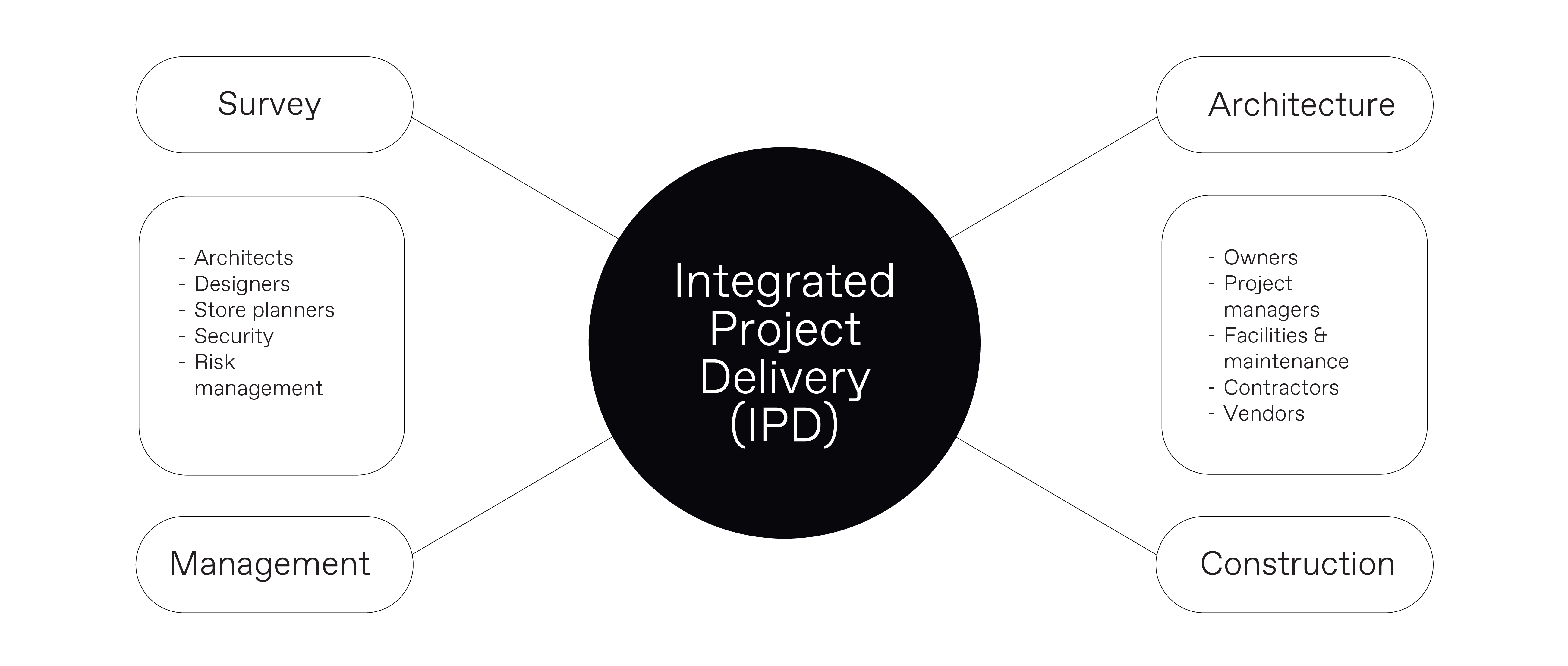
The Integrated Project Delivery Method

What is the integrated project delivery method?
Integrated Project Delivery (IPD) is an alternative construction project delivery method that seeks the efficiency and involvement of all participants (people, systems, business structures and practices) through all phases of design, fabrication, and construction.
IPD combines ideas from integrated practice and lean construction. The objectives of IPD are to:
- increase productivity
- improve efficiency
- avoid time overruns
- enhance final product quality, and
- reduce conflicts between owners, architects and contractors.
The integrated project delivery process
In practice, the IPD system is a process where all disciplines in a construction project work as one firm. The primary team members include the architect and key technical consultants, as well as a general contractor and subcontractors. The IPD process is generally as follows:
Step 1: Owner selection
The owner selects the project team, including the architect, key technical consultants, and a general contractor.
Step 2: Visioning
The team develops a shared vision for the project, including goals, objectives, and desired outcomes.
Step 3: Project delivery plan
The team develops a project delivery plan that outlines how the team will work together and share risk and reward. This plan should include the following:
- Roles and responsibilities of each team member
- Communication and decision-making processes
- Risk management approach
- Compensation structure
Step 4: Design
The team works together on the design of the project, using lean principles to identify and eliminate inefficiencies. This includes using building information modeling (BIM) to share information and collaborate more effectively.
Step 5: Construction
The team works together on the construction of the project, using lean principles to optimise the construction process. This includes using prefabrication and modular construction techniques to reduce waste and improve efficiency.
Step 6: Closeout
The team shares in the rewards of the project, based on a predetermined formula.
Additional steps that may be included in the IPD process:
- Value engineering: The team conducts value engineering workshops to identify opportunities to improve the value of the project without sacrificing quality.
- Lean construction training: The team receives training on lean construction principles and practices.
- Regular team meetings: The team meets regularly to discuss progress, identify and resolve problems, and make decisions.
The bottom line is that the IPD process is flexible and can be adapted to the specific needs of each project.

Integrated project delivery vs traditional design-build
The main difference between Integrated Project Delivery and traditional design-build is the level of collaboration between the project participants. In IPD, all project participants work together as a team under a single contract. In traditional design-build, the owner contracts with a design-build entity, which is responsible for both the design and construction of the project.

Integrated project delivery examples in construction
Autodesk AEC Solutions Division Headquarters
This 55,000 square foot tenant improvement project used IPD to achieve high sustainability goals. The project team used BIM to collaborate on the design and construction of the project, and they also used lean principles to identify and eliminate waste from the project process. As a result of these efforts, the project was able to achieve LEED-CI Platinum certification and reduce its energy consumption by 50% compared to a baseline building.
Sutter Health Fairfield Medical Office Building
This project was under budget and within schedule using IPD. The project team used IPD to improve communication and collaboration among project participants, which helped to reduce conflict and delays. The team also used lean principles to identify and eliminate waste from the project process.
Cardinal Glennon Children's Hospital Expansion
This project used IPD to improve communication and collaboration among project participants. The project team used weekly meetings to discuss progress, identify and resolve problems, and make decisions. The team also used a shared project schedule and budget to keep everyone on the same page. As a result, the project was able to be completed on time and within budget, and the project participants were able to build stronger relationships. (Source)
Integrated project delivery pros vs cons
Improved project outcomes:
IPD projects have been shown to have better on-time and on-budget performance, as well as higher quality outcomes.
Reduced conflict:
The collaborative nature of IPD helps to reduce conflict between project participants.
Increased innovation:
IPD encourages team members to share ideas and collaborate on new solutions.
Improved relationships:
IPD helps to build stronger relationships between project participants, which can lead to future projects being more successful.
Increased complexity:
IPD can be more complex to implement and manage than traditional project delivery methods.
Increased upfront costs:
IPD projects may have higher upfront costs due to the need for team development and communication.
Need for trust and collaboration:
IPD requires a high level of trust and collaboration between all project participants.
Alternatives to the integrated project delivery model
Agency CM
Agency CM, or Agency Construction Management, is a project delivery method in which the owner hires a construction manager (CM) to provide preconstruction services and to manage the construction of the project. The CM is usually hired early in the project planning process and works closely with the owner to develop the project design and budget. The CM also selects and manages the subcontractors who will construct the project.
Construction manager at risk (CMAR)
In a CMAR project, the owner hires a construction manager to provide preconstruction services and to manage the construction of the project, as in agency CM. The difference is that the construction manager also assumes some of the risk associated with the project.
Public private partnership (PPP)
A public-private partnership (PPP) is a contractual arrangement between a public agency and a private sector entity. In a PPP, the private sector entity provides financing, design, construction, operation, and maintenance of a public infrastructure project. PPPs are often used for large and complex infrastructure projects, such as highways, bridges, and water treatment plants.
Design bid build
Design bid build (DBB) is the most traditional project delivery method. Also known as traditional design build (TDB), in a DBB project the owner hires a designer to develop the project design and then hires a contractor to construct the project based on the design. The DBB process is typically competitive, with the owner selecting the designer and contractor based on their bids.
Alliance contracting
Alliance contracting is a collaborative project delivery method in which the owner, designer, contractor, and other stakeholders work together as a single team to deliver the project. The team shares all risks and rewards equally. Alliances are typically used for very large and complex projects with a high degree of uncertainty.
Progressive design build (PDB)
Progressive design-build (PDB) combines the benefits of design-build with a phased approach to design and construction. In PDB, the owner and design-builder work together to develop a preliminary design and budget for the project. Once approved, the owner and design-builder enter into a contract to complete the detailed design and construction of the project, allowing for changes to the design and budget as needed.
Design-build-finance-maintain (DBFM)
DBFM is a comprehensive project delivery method that includes the design, construction, financing, and maintenance of the project. The design-build firm is responsible for all aspects of the project, from the initial concept to the final completion.